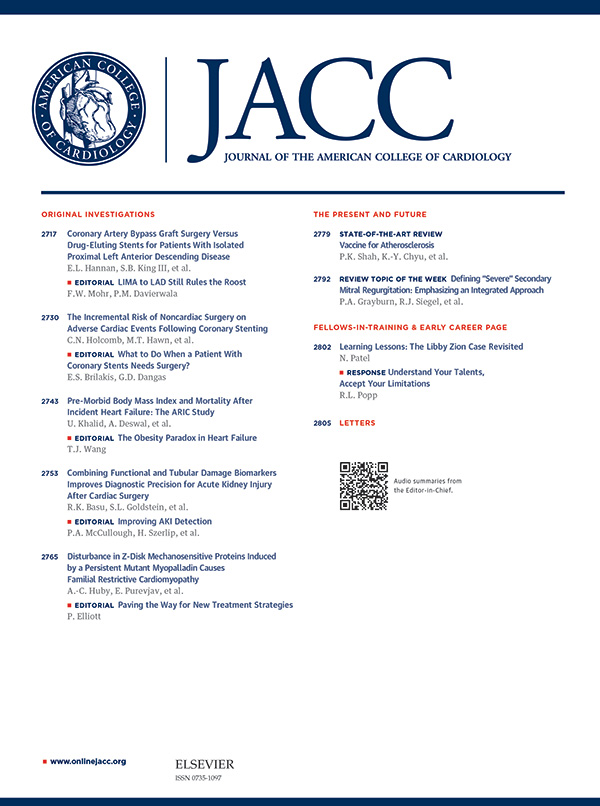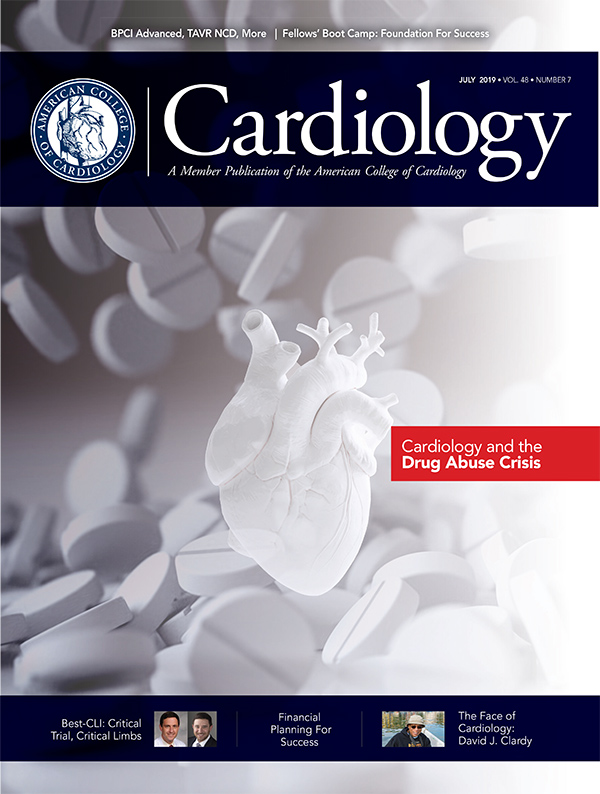JACC in a Flash
Featured topics and Editors' Picks from all of ACC's JACC Journals.
Are Young Female Smokers at Greater Risk For STEMI?

Smoking increases the risk of acute STEMI in both men and women at all ages. But findings in a study published in the Journal of the American College of Cardiology show that women smokers have a significantly higher increased risk compared with men, especially women under 50 years old.
Despite the increased risk, smokers can reduce their risk to that of a never smoker in as little as a month after quitting.
James Palmer, BMedSci, MBChB, et al., used a retrospective ecological cohort study to compile data for all patients in the South Yorkshire region of the U.K. who presented with acute STEMI between January 2009 and July 2014, which included 3,343 STEMIs. The percentage who were current smokers was similar between genders (46.8 percent of female patients and 47.6 percent of male patients).

They found that smoking increases STEMI risk in all patients, regardless of age or gender – however, the risk is higher in women compared with men at all ages. The largest relative risk difference between women and men was in the age group of 50-64 years.
Notably, the greatest increase in risk in both women and men was in the youngest age group (18-49 years). In this group, women who smoked had a 13-times greater risk of STEMI compared with their nonsmoking female contemporaries. In men in this age group, the increased risk for STEMI was 8.6-times higher.
Why is the risk for STEMI higher in younger women who smoke? The investigators suggest that smoking may lower levels of serum estrogen, known to have protective effects against atherosclerosis. Men tend to have larger coronary arteries than women, thus the chronic inflammation from smoking may lead to a greater degree of arterial narrowing in women than men. Several other vascular conditions are more prevalent in female STEMI patients, including vasospasm, vasculitis and spontaneous coronary artery dissection.
The researchers also speculate that professional advice on smoking cessation may differ between genders if smoking is considered to be less of a cardiac risk for women than men.
"Our study found that smoking cessation, regardless of age or gender, reduces STEMI risk to that of a never smoker, possibly within a month," says senior author Ever Grech, MD, FACC. "Patients who smoke merit encouragement to give up their habit, and this study adds quantitative evidence to the massive benefits of doing so."
In a related editorial, Eric C. Stecker, MD, FACC, and Thomas A. Dewland, MD, explain that, "The work of Palmer et al., underscores the important role that smoking plays in the morbidity and mortality of every cardiologist's patients, and it reminds us of the great impact we can have if we approach our task with constancy and purpose."
Palmer J, Lloyd A, Steele L, et al. J Am Coll Cardiol 2019;73:3259-66.
E-Cigarette Liquids: Endothelial Cell Dysfunction, Nicotine Delivery

Acute exposure to flavored e-cigarette liquids or e-cigarette use may exacerbate endothelial cell dysfunction, according to research published in the Journal of the American College of Cardiology.
Won Hee Lee, PhD, et al., used induced pluripotent stem cells-derived endothelial cells (iPSC-ECs) from three healthy individuals and a subject population consisting of five healthy nonsmokers, five active cigarette smokers, two dual users of e-cigarettes and cigarettes, and two sole users of e-cigarettes.
All subjects were healthy individuals free of other major cardiovascular risk factors. The researchers examined the effects of e-liquids on endothelial cell viability by treating the iPSC-ECs with a dilution of six commercially available e-liquids at varying nicotine concentrations.

The researchers found all six flavored e-liquids had varying effects on cell survival and observed the presence of pro-inflammatory markers known to play a critical role in the development of vascular disease.
The fruit-flavored, sweet tobacco with undertones of caramel and vanilla flavored, tobacco-flavored Red Oak Tennessee Cured, and sweet-flavored Butter Scotch all had moderate toxic effects on the cells, with the strongest toxic effect coming from the cinnamon-flavored Marcado. The menthol tobacco-flavored Tundra had a strong toxic effect at a 1 percent dose concentration with or without nicotine.
Notably, the researchers also found the use of e-cigarettes may increase plasma nicotine concentrations to similar levels found with the use of conventional cigarettes, indicating that e-cigarettes provide effective and measurable nicotine delivery.
"Although limited by a small sample size, our data suggest that e-cigarette use can lead to acute endothelial dysfunction, which we validated by in vitro exposure to either e-liquid or serum derived from patients using e-cigarettes," says Joseph C. Wu, MD, PhD, FACC, the study's senior author.
"E-cigarette use in the U.S. and worldwide is rapidly increasing with growing concerns from the scientific, public health and policy making communities. Our findings are an important first step in filling this gap by providing mechanistic insights on how e-cigarettes cause endothelial dysfunction, which is an important risk factor for the development of heart disease."
In an accompanying editorial comment, Jane E. Freedman, MD, and Chinmay M. Trivedi, MD, PhD, add that moving forward, "additional product and safety testing appear necessary to clarify the dangerous components of these products."
Lee WH, Ong S-G, Zhou Y, et al. J Am Coll Cardiol 2019;73:2722-37.
Post-PVI Major Bleeding Increases Mortality Risk: NCDR Study

Major bleeding occurs in about 4 percent of peripheral vascular intervention (PVI) procedures, leading to an increased risk of inhospital mortality, according to a study published in JACC: Cardiovascular Interventions. The study is the first published research using data from ACC's PVI Registry.
Bhaskar Bhardwaj, MD, et al., used the PVI Registry data to analyze 18,289 PVI patients at 76 hospitals to assess major bleeding within 72 hours of the procedure. They also looked at inhospital mortality among patients with and without major bleeding and characteristics independently associated with post-PVI bleeding.
Major bleeding was defined as a hemoglobin drop of ≥3 g/dL, any hemoglobin decline ≥4 g/dL, or the need for a blood transfusion in patients with preprocedure hemoglobin of >8 g/dL.
Major bleeding occurred in 744 patients (4.1 percent). The inhospital mortality rate was higher among patients with major bleeding at 6.6 percent vs. 0.3 percent among patients without major bleeding.
Women, older patients, and those with heart failure or anemia were more likely to experience major bleeding. In addition, major bleeding was more common with nonfemoral vascular access and the use of thrombolytic therapy.
The study demonstrates that post-PVI bleeding is "strongly associated with in-hospital mortality," the researchers conclude, adding that additional research "is needed to develop strategies that would maximize the safety of PVI."
In an editorial comment, Douglas E. Drachman, MD, FACC, and Beau M. Hawkins, MD, FACC, write the study establishes that bleeding is a "common complication" of PVI and "confers significant clinical risk." They conclude the study "represents an opportunity to establish best practices and improve patient outcomes."
Bhardwaj B, Spertus JA, Kennedy KF, et al. JACC Cardiovasc Interv 2019;12:1140-49.
Some HF Patients May Benefit From CRT-D: NCDR ICD Registry

Heart failure (HF) patients with nonspecific intraventricular conduction delay (NICD) with a long QRS may see improved heart function with CRT-D if traditional ICD treatment does not work, according to research published in the Journal of the American College of Cardiology.
Hiro Kawata, MD, PhD, FACC, et al., aimed to determine the benefit of CRT-D in patients with non-left bundle branch block (LBBB). They evaluated data between 2010-2013 from the NCDR ICD Registry. The researchers divided patients with right bundle branch block (RBBB) and NICD into two groups according to the length of their QRS.
The study compared patients who had either an CRT-D or an ICD. Among 5,954 Medicare-aged patients with NICD or RBBB who were implanted with a defibrillator, the study found patients with NICD and a QRS of more than 150 ms responded best to CRT-D.
In these patients, CRT-D was associated with decreased risk of death, readmission to the hospital for any cause, as well as readmission for heart-failure related causes, compared with a similar group of patients implanted with ICD.
Among patients with RBBB, CRT-D was not associated with better outcomes compared with ICD, regardless of the duration of their QRS.
"This means that if you have a patient with RBBB who is still suffering from heart failure symptoms after medical therapy, there is not enough data to support using CRT blindly," Kawata says. "But in NICD patients, we now know that those with a long QRS are likely to benefit from CRT."
He adds more study is needed to establish whether certain RBBB patients might respond to CRT.
"While implanting a CRT-D is relatively safe, it is not without risks," he says. CRT can cause complications, including infection, a pneumothorax or cardiac perforation.
In an editorial, Michael Gold, MD, PhD, FACC, notes the study results provide important data indicating that not all non-LBBB types, or morphologies, are the same.
"The authors should be commended for providing more detailed analysis of the electrocardiogram and not simply using what is now the conventional LBBB vs. non-LBBB morphologies," he says.
"These findings will need to be confirmed with further studies, either from prospective trials or pooled data from previous randomized trials. However, importantly, the results of the present study challenge our convention of lumping CRT candidates into two categories."
Kawata H, Bao H, Curtis JP, et al. J Am Coll Cardiol 2019;73:3082-99.
Cognitive Decline May Accelerate After MI, Angina

Adults with incident coronary heart disease (CHD) are at higher risk for faster cognitive decline in the long-term, found a study published in the Journal of the American College of Cardiology.
This study is one of the largest longitudinal studies investigating the progression of cognitive decline before and after CHD diagnosis. Wuxiang Xie, PhD, et al., included data from a total of 7,888 stroke-free participants from the English Longitudinal Study of Aging (ELSA), a community-based, biannual, cohort study of adults age 50 and older, running from 2002 to 2017.
The study excluded individuals who had a history of stroke, heart attack and/or angina, had a confirmed diagnosis of dementia and/or Alzheimer's disease, or had an incident of stroke during follow-up.
Three cognitive tests were used to assess participants' cognitive function in eight waves across a 12-year follow-up period. First, verbal memory was assessed by testing immediate and delayed recall of 10 unrelated words.
Second, participants were asked to verbally name as many different animals as possible in one minute to test semantic fluency. Third, temporal orientation was assessed through four questions regarding the current date (day, month, year and day of the week). Higher scores indicated better cognitive function.
During the study period, 5.6 percent of participants experienced a myocardial infarction (MI) or angina. Those with CHD showed faster rates of cognitive decline in all three tests.
Patients diagnosed with angina showed a robust decline in temporal orientation, whereas MI patients had significant cognitive decline in verbal memory and semantic fluency, and worse overall cognitive decline.
The researchers found no association between cognitive decline and pre-CHD diagnosis, nor a short-term cognitive decline after the CHD event occurred. They report that CHD might directly contribute to cognitive decline due to the lack of oxygen to the brain.
In an editorial comment, Suvi P. Rovio, PhD, writes the links between cardiovascular and brain health suggest that compromised cardiovascular risk factor levels from early age may damage both vascular and neural tissues of the brain.
"This study provides evidence on the role of incident coronary heart disease as a possible factor bending the course of cognitive decline trajectory in older age," she writes.
"While primordial and primary prevention would be the most optimal outlooks to postpone clinical cognitive impairment, it is crucial to identify specific at-risk populations for targeted secondary and tertiary prevention."
Xie W, Zheng F, Yan L, Zhong B. J Am Coll Cardiol 2019;73:3041-50.
NCDR: Mortality After TAVR Higher in Dialysis-Dependent Patients

Patients undergoing TAVR who have end-stage renal disease (ESRD) and are dialysis-dependent may have a higher risk of mortality than patients who are not dependent on dialysis, found a study published in the Journal of the American College of Cardiology.
Using data from the STS/ACC TVT Registry, Molly Szerlip, MD, FACC, et al., looked at 72,631 patients with severe aortic stenosis treated with TAVR and compared in-hospital and one-year outcomes in ESRD vs. nondialysis patients.
Overall, patients with ESRD were younger than nondialysis patients (78 years vs. 84 years), more likely to be male (58.3 vs. 48.5 percent), and more likely to be African American (11.4 vs. 3.3 percent).
ESRD patients also had higher rates of peripheral arterial disease, hypertension, diabetes, previous myocardial infarction and heart failure symptoms. No difference in previous coronary revascularization, stroke or atrial fibrillation was seen between the two groups.
The ESRD group had a higher rate of complications and a longer average stay in the intensive care unit (six days vs. five days). In addition, the ESRD group had a higher rate of in-hospital mortality (5.1 vs. 3.4 percent) and major bleeding (1.4 vs. 1 percent).
But the two groups had similar rates of major vascular complications (4.5 for ESRD patients vs. 4.6 percent for nondialysis patients). The one-year mortality rate was significantly higher in ESRD patients (36.8 percent), compared with nondialysis patients (18.7 percent).
According to the researchers, the study's findings that ESRD is associated with increased mortality at 30 days and one year in TAVR patients have "important potential implications in patient selection, and therefore, careful patient selection to optimize use of this procedural resource is necessary."
In an editorial comment, George Bayliss, MD, explains that "TAVR is a high-risk procedure for anyone with ESRD on dialysis or even approaching the need for dialysis."
He adds that moving forward, more research is needed to identify ESRD patients with aortic stenosis who would benefit from TAVR and that the "procedure carries high risk and may, at best, only buy a little more time" even for carefully selected patients.
Szerlip M, Zajarias A, Vemalapalli S, et al. J Am Coll Cardiol 2019;73:2806-15.
Keywords: ACC Publications, Cardiology Magazine, Anemia, Atherosclerosis, Blood Transfusion, Cardiovascular Diseases, Cell Survival, Bundle-Branch Block, Cinnamomum zeylanicum, Coronary Vessel Anomalies, Electrocardiography, Defibrillators, Heart Failure, Hemoglobins, Estrogens, Induced Pluripotent Stem Cells, Inflammation, Hospital Mortality, Medicare, Patient Readmission, Nicotine, Pneumothorax, Policy Making, Prospective Studies, Quercus, Public Health, Research Personnel, Registries, Retrospective Studies, Risk, Risk Factors, Sample Size, Smoking, Smoking Cessation, Myocardial Infarction, Tobacco, Tobacco Products, Vascular Diseases, Vasculitis
< Back to Listings

